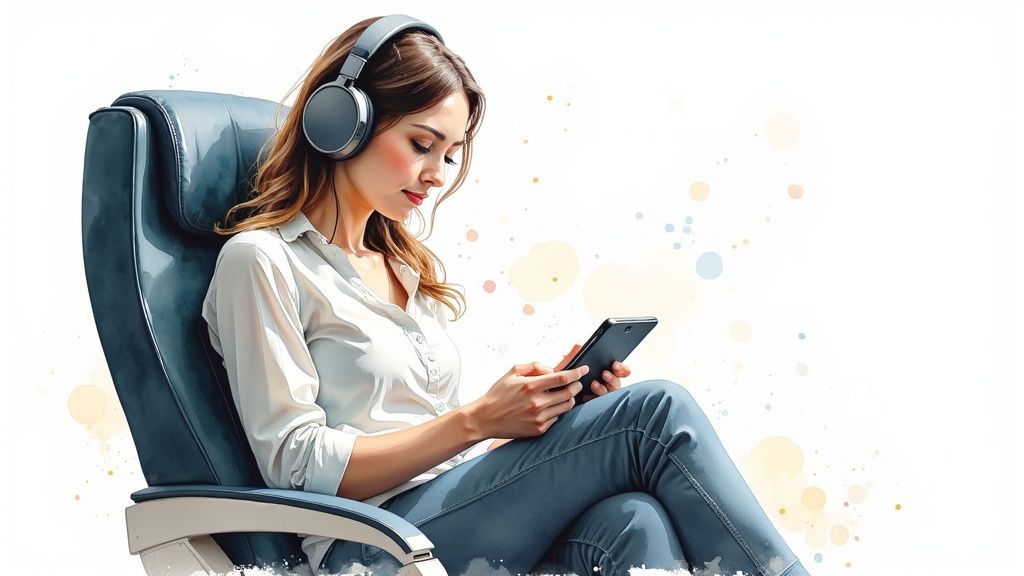
Dealing with anxiety on a plane starts with a simple, powerful truth: your feelings are valid, common, and you absolutely can heal from them. The goal isn't just to manage fear, but to understand that a life free from panic is entirely possible. It’s about reclaiming your sense of control and seeing flying not as an ordeal, but as a doorway to the world that you can confidently walk through.
Understanding Your Fear of Flying And How to Overcome It

That feeling of a racing heart as the cabin door closes? You’re not alone, and you don't have to feel that way forever. For so many people, it’s more than just a minor worry; it’s an overwhelming sensation that dictates travel plans and life experiences. If that sounds familiar, you're in the right place to start a journey toward lasting freedom.
The first step toward true healing is recognizing that what you're experiencing has a name—and a solution. It's not a personal failing. In fact, approximately 25 million adults in the United States feel some form of anxiety about flying. This condition, known as aviophobia, can range from pre-flight nervousness to a phobia that keeps you grounded, but it doesn't have to be a life sentence.
Pinpointing Your Triggers
To truly heal from this fear, you have to get to know it a little better. Flight anxiety isn't a single, one-size-fits-all fear. It’s usually a combination of several underlying worries that feed off each other until you feel panicked.
What's really driving the anxiety? It often boils down to a few common culprits:
- Loss of Control: This is a big one. You're handing over control to the pilots, the flight crew, and a machine you don't understand. That can be profoundly unsettling.
- Claustrophobia: The tight, enclosed space of an airplane cabin can make you feel trapped and helpless before you even leave the ground.
- Fear of Heights (Acrophobia): For some, the simple awareness of being thousands of feet in the air is enough to trigger intense fear.
- Worry About Mechanical Failure or Turbulence: Every strange noise or sudden bump feels like a direct threat, even when it’s a completely normal part of flying.
The most important thing to remember is this: These feelings do not have to define you or your future travels. This isn't just about managing fear; it's about reclaiming your freedom and realizing a panic-free life is within your reach.
Shifting from Fear to Possibility
This guide is designed to be your roadmap, filled with practical strategies that put you back in the pilot's seat of your own well-being. My goal is to show you, right from the start, that flying with a sense of calm and confidence is an achievable reality and a stepping stone to a life where anxiety no longer calls the shots.
Your journey toward a panic-free flight begins with the belief that you can change your relationship with flying. For a more structured deep-dive, our comprehensive resources can help you on this path to healing and freedom: https://anxietychecklist.com/anxiety-university.
It’s time to move from a place of dread to one of genuine hope.
Lay the Groundwork for a Calm Flight Before You Even Leave
A peaceful journey doesn’t start at the airport gate—it begins days before you pack your bags. When you know how to handle anxiety on a plane, it's less about fighting panic at 30,000 feet and more about smart, proactive preparation. This is your chance to reclaim control and channel that nervous energy into confident, deliberate action, proving to yourself that you are capable of calm.
Something as simple as choosing your seat can make a world of difference. Seats over the wing, for instance, are closer to the plane’s center of gravity and tend to feel less turbulence. If you get claustrophobic, an aisle seat can feel like a lifeline, giving you a bit more space and the freedom to get up without asking anyone to move.
Create Your Personal Comfort Kit
One of the best things you can do is assemble a personal "comfort kit" filled with items that ground you. This isn't just about finding distractions; it's about actively engaging your senses to pull your mind back to the present moment. Think of it as your in-flight support system, packed and ready to help you feel secure.
A few things I never fly without include:
- Noise-canceling headphones: These are non-negotiable for me. They block out the unfamiliar engine sounds and let you create a calm bubble with your favorite music, a podcast, or even a guided meditation.
- Something with a familiar scent: A small vial of lavender essential oil or a scarf spritzed with a comforting perfume can be incredibly soothing. Our sense of smell is powerfully linked to memory and emotion.
- Your favorite snacks and drinks: Having familiar treats on hand gives you a sense of comfort and control, so you're not at the mercy of whatever the in-flight service offers.
- Grounding objects: This could be a smooth stone you carry, a stress ball, or even a piece of soft fabric. The tactile sensation gives your brain something concrete to focus on instead of anxious thoughts.
Practice Mental Rehearsal
Another powerful technique is mental rehearsal. This is way more than just "thinking positive"—it's a structured visualization where you mentally walk through your entire travel day, picturing every single step going smoothly and calmly.
Close your eyes and imagine yourself breezing through security, finding your gate with time to spare, and settling into your seat feeling totally relaxed. Picture the plane taking off gently as you get lost in a good book or movie. Visualize a smooth landing and that incredible feeling of accomplishment as you step off the plane, knowing you did it.
When you run through this positive "mental movie" over and over, you're essentially training your brain to expect a calm experience instead of defaulting to a stressful one. You are building a new, hopeful future.
Before you go, here’s a quick checklist you can use to make sure you’ve covered all your bases. It’s designed to give you small, actionable wins that build a sense of control and preparedness in the days leading up to your trip.
Your Pre-Flight Anxiety Checklist
| Action Item | Why It Helps | When to Do It |
|---|---|---|
| Choose Your Seat Strategically | An aisle seat provides freedom; a seat over the wing may feel less turbulence. | When booking your ticket |
| Pack Your Comfort Kit | Puts grounding tools and familiar items at your fingertips, reducing uncertainty. | 2-3 days before your flight |
| Download Entertainment | Having movies, music, or podcasts ready means no reliance on spotty Wi-Fi. | The day before you fly |
| Practice Mental Rehearsal | Trains your brain to anticipate a calm, smooth journey from start to finish. | Daily, in the week leading up to your flight |
| Check In Online | Eliminates one major stressor at the airport, letting you bypass long lines. | 24 hours before departure |
| Eat a Nourishing Meal | A balanced meal stabilizes blood sugar, preventing mood swings or jitters. | 2-3 hours before leaving for the airport |
| Arrive at the Airport Early | Removes the rush and panic of potentially missing your flight. | 2-3 hours before a domestic flight; 3-4 for international |
Following these steps helps transform what feels like a huge, overwhelming event into a series of small, manageable tasks. It's about taking back your power, one step at a time.
This pre-flight routine is a foundational step in your journey. It transforms anxiety into empowerment, allowing you to arrive at the airport feeling resilient and prepared, not just for the flight, but for any challenge.
Building these proactive habits is central to overcoming anxiety in the long run. By focusing on what you can control before you even leave home, you build a strong foundation for a panic-free life. If you're looking for a structured way to apply this mindset to other areas, you can learn more about the complete anxiety recovery steps we recommend. Taking these small, manageable actions is how lasting change begins, proving to yourself that a world of travel and freedom is entirely within your reach.
How to Navigate the Airport with Confidence

For a lot of us, the real battle with flight anxiety starts long before we even step onto the plane. The airport itself—a whirlwind of long lines, echoing announcements, and people rushing everywhere—can be a massive trigger. It can drain your mental batteries before you even get to the gate.
But it doesn't have to be that way. With a few smart strategies, you can walk through that terminal feeling calm and in control, knowing that peace is possible even in a busy place.
Your most powerful tool? Time. Getting to the airport early isn't just about not missing your flight. It's a strategic move that gives you the space to breathe and handle everything at your own pace. When you aren't rushing, the airport transforms from a stressful obstacle course into just another part of the journey.
Ground Yourself While You Wait
Standing in line—whether for check-in or security—is often when the anxious "what if" thoughts start to spiral. Instead of letting your mind race, you can anchor yourself in the present moment with a simple grounding technique.
One of the most effective and discreet methods I've come across is the 5-4-3-2-1 technique. It pulls your focus away from that internal panic and directs it to the world around you.
- 5: Name five things you can see. (A departure screen, another traveler's bright blue suitcase, the pattern on the carpet.)
- 4: Identify four things you can feel. (The smooth surface of your phone, the texture of your jacket, your feet solid on the floor.)
- 3: Acknowledge three things you can hear. (A distant announcement, the rattle of a suitcase, the low hum of conversation.)
- 2: Name two things you can smell. (The aroma from a coffee shop, the faint scent of someone's perfume.)
- 1: Identify one thing you can taste. (The minty gum you're chewing, the lingering flavor of your morning coffee.)
This little exercise is incredibly powerful for hitting the brakes on an anxiety spiral. It helps you conserve your mental energy so you can board feeling centered, not completely drained.
Keep in mind that outside stress can pour gasoline on these feelings. Psychological studies confirm a strong link between high stress from work or personal life and a bigger fear of flying. By getting a handle on your overall stress, you're also taking a big step toward calming your flight anxiety. You can find more on the connection between stress and aviophobia in this in-depth research.
Your main job at the airport is to protect your mental and emotional energy. Every strategy, from getting there early to using grounding exercises, is about saving your inner calm so you can face the flight itself with more confidence.
Communicate Your Needs
You absolutely do not have to go through this alone. Letting people know what you need is a sign of strength, not weakness, and it's a practical way to build a little support system around yourself.
If you're flying with a partner or a friend, come up with a simple plan beforehand. It could be something as easy as, "Hey, if I start looking anxious, can you ask me about our vacation plans to get my mind on something else?"
You can also quietly let a gate agent know you're a nervous flyer. Trust me, they see it every single day. They're professionals and can often offer a bit of reassurance or just a friendly, understanding smile—which can make a world of difference.
In-Flight Techniques to Manage Anxiety in the Moment
The moment that cabin door clicks shut and the plane starts to taxi, your mind can feel like a pretty turbulent space. This is where having a few go-to techniques in your back pocket makes all the difference. The strategies here are discreet, powerful, and designed to help you handle anxiety right when it hits.
Here's the most important thing to hold onto: anxiety is a temporary feeling, not a permanent state. Every time you successfully use one of these coping tools, you're actively teaching your brain a new, calmer way to respond. You're proving to yourself, in real-time, that you have the strength to ride out any wave of panic and land peacefully on the other side.
Master Your Breathing to Calm Your Nervous System
When anxiety spikes, our breathing is often the first thing to go haywire. It gets shallow and fast, which basically screams "danger!" to our nervous system. But you can flip that switch by intentionally taking back control of your breath. Doing so sends a direct message to your brain that everything is actually okay.
One of the most effective methods out there is box breathing. It's a simple technique used by everyone from Navy SEALs to nurses to keep cool under pressure.
- Inhale slowly through your nose for a count of four.
- Hold your breath at the top for another count of four.
- Exhale slowly through your mouth, again for a count of four.
- Hold your breath at the bottom for a final count of four.
Just repeat that cycle for a few minutes. The rhythm and focus it demands pull your mind away from anxious thoughts and physically slow your heart rate down. For a deeper dive, check out our complete guide on breathing exercises for anxiety that you can practice anywhere, anytime.
Every controlled breath you take is a small act of empowerment. It's a quiet declaration that you are in charge of your body and mind—not the anxiety.
Challenge Anxious Thoughts with Cognitive Reframing
Anxious thoughts are rarely logical. They're fueled by "what if" scenarios that spiral out of control. Cognitive reframing is the practice of catching these thoughts and actively challenging them with more rational, realistic ones.
Let's say the plane hits a patch of turbulence and your mind immediately jumps to the worst possible conclusion. Instead of letting that thought run wild, you catch it. You challenge it.
- Anxious Thought: "That bump felt terrible! Something must be wrong with the plane."
- Reframed Thought: "Turbulence is just like bumps in the road. Planes are built to handle this, and the pilots are experts. This feeling is uncomfortable, but it's not dangerous."
This intentional shift interrupts the panic cycle before it can gain momentum. It doesn’t pretend your feelings aren't real; it just grounds them in reality. Media coverage of aviation incidents often makes our fears feel much more likely than they are—a mental shortcut known as the availability heuristic. It’s powerful to arm yourself with the facts: flying is statistically the safest way to travel.
In-Flight Anxiety Response Techniques
When you feel that familiar spike of anxiety, it helps to have a quick reference guide. Think of this table as your in-flight menu for calm. Different situations call for different tools, and knowing which one to reach for can make all the difference.
| Technique | Best For | How to Do It |
|---|---|---|
| Box Breathing | Sudden physical symptoms (racing heart, shortness of breath) | Inhale for 4, hold for 4, exhale for 4, hold for 4. Repeat until you feel your heart rate slow. |
| Cognitive Reframing | Spiraling "what if" thoughts and catastrophizing | Actively challenge the anxious thought with a logical, fact-based alternative. |
| Sensory Grounding | Feeling detached, overwhelmed, or "in your head" | Focus intensely on one sense: the texture of the seat, the hum of the engine, the smell of your coffee. |
Choosing the right technique for the moment empowers you to respond effectively instead of just reacting to the fear. Each one works on a different part of the anxiety response—physical, mental, and emotional—giving you a comprehensive toolkit to handle whatever comes your way.
Use Sensory Grounding to Anchor Yourself
When your thoughts are spiraling, sensory grounding techniques are like dropping an anchor in the present moment. The idea is to pull your attention away from the "what ifs" in your head and focus it squarely on your physical sensations.
These methods are simple, discreet, and surprisingly effective.
- Focus on Touch: Press your feet firmly into the floor. Feel the texture of the armrest or the fabric of your jeans. Clasp your hands together and notice the pressure.
- Engage Your Hearing: Pop in some noise-canceling headphones. Listen to a playlist that makes you feel good, a familiar podcast, or a guided meditation.
- Use Your Sense of Smell: A little bit of calming essential oil (like lavender) on a tissue or your wrist can work wonders. Inhale deeply and focus only on the scent.
This infographic breaks down just how effective different on-board techniques can be for finding relief.

As you can see, tools like mindfulness and positive self-talk offer significant relief, proving just how powerful these mental and sensory strategies are. You have a whole host of effective options to choose from when you need them most.
Building Long-Term Freedom from Flight Anxiety

Successfully getting through one flight is a huge accomplishment. But the real goal is true, lasting freedom—not having to spend weeks dreading your next trip. This is about building a life where flying is just another part of your travels, not a monumental obstacle you have to conquer.
And the most powerful thing to realize? Healing is entirely possible.
A life free from flight panic starts by getting to the root of the fear, not just managing the symptoms when they flare up. This is where you shift from simply coping in the moment to creating permanent change in your relationship with air travel.
Rewiring Your Anxious Brain
Lasting change means systematically altering the thought patterns that fuel your fear in the first place. This is where therapies like Cognitive Behavioral Therapy (CBT) come in, and they are incredibly effective. CBT helps you catch, challenge, and replace the catastrophic thoughts that send your anxiety soaring on a plane.
You learn to see a strange sound not as a sign of impending doom, but as a completely normal operational noise. It’s a structured way to retrain your brain's automatic fear response. Over time, this practice builds a foundation of logical thinking that can hold its ground against the emotional pull of anxiety, paving the way for a panic-free future.
Another powerful approach is gradual exposure. Now, this doesn't mean you have to book a 12-hour flight tomorrow. It’s all about taking small, manageable steps to face your fear in a controlled way, proving to yourself again and again that you are safe. Learning about the principles of exposure therapy for anxiety can give you some great insights into how this structured process helps you reclaim your confidence.
The goal isn't to be fearless; it's to feel the fear and know you have the tools and resilience to handle it. This mindset shift is the key to unlocking a world of travel possibilities.
Reframing Every Flight as a Success
One of the most important things you can do is learn to see every single flight as a successful practice run. Instead of viewing it as an ordeal to be survived, reframe it as an opportunity to master your new skills.
Each time you use a breathing technique, challenge an anxious thought, or simply make it to your destination, you are strengthening your "calm flying" muscle.
This reframing turns what was once a journey of dread into one of gradual mastery. You start collecting real-world evidence of your own capability, which makes the next flight feel just a little less daunting.
For some, true freedom from flight anxiety also means rediscovering the joy of travel in other ways. When you feel ready, you might even consider exploring the serene world of luxury train travel for a truly calming and beautiful journey.
Ultimately, remember that you are in control. With the right strategies and a commitment to shifting your mindset, you can permanently transform your relationship with flying and open up a world that once felt completely out of reach.
Common Questions About Flight Anxiety
Even with the best game plan, it's natural for specific worries to pop up. Changing your relationship with flying is a process, and having lingering questions is a totally normal part of it. Sometimes, getting a clear, straightforward answer is all you need to feel a little more grounded.
This isn't about being perfect. Every question you ask and every little technique you try is one step closer to getting on a plane without that familiar sense of dread. There is so much hope for a different future.
Is It Better to Take Medication for Flight Anxiety?
Medication can be an incredibly helpful tool for some people, but it's definitely not a one-size-fits-all fix. The absolute first and most important step is to talk to your doctor. They're the only ones who can tell you if a prescription is a good fit for you and walk you through any side effects.
Many people find that a combination of coping strategies and medication works wonders. Others get amazing results using behavioral techniques alone. The best approach is always the one that feels right for you—one that puts you back in the driver's seat of your own journey to healing.
What Should I Do If I Have a Panic Attack on the Plane?
If you feel that awful, intense wave of a panic attack starting, the first thing to do is ground yourself. Right here, right now. Press your feet firmly into the floor. Grip the armrests and really feel their texture and temperature. Then, get your breathing back on your terms with slow, deliberate breaths.
Give yourself a simple, powerful mantra: "This is just a feeling. It is temporary, and it will pass."
If you're comfortable with it, a quiet word to a flight attendant or your travel buddy can make a world of difference. Pulling a sensory item from your carry-on, like a stress ball or a rollerball with a calming scent, can also give your brain something else to focus on and help the feeling fade. Learning to recognize what sets you off is a huge advantage, and you can start by exploring some of the most common anxiety triggers people experience.
Remember: A panic attack feels terrifying, but it is not dangerous. It’s just your body's alarm system going haywire. You have what it takes to ride it out safely, and you can learn to stop them from happening altogether.
Will Telling the Flight Crew About My Anxiety Really Help?
Yes, it absolutely can. Flight attendants are pros, and they deal with nervous flyers every single day. You don't need to make a big announcement. A quiet word as you board—something as simple as, "Just to let you know, I'm a bit of an anxious flyer"—is all it takes.
This gives them the heads-up to offer a little extra reassurance if there are strange noises, check in on you, or just bring you a glass of water. Just knowing you have an ally on board can dramatically dial down that feeling of being totally alone with your fear.
At The Anxiety Checklist, we believe that understanding your anxiety is the first step toward overcoming it and living a panic-free life. Our comprehensive Fearless Living system is designed to give you the practical tools and cognitive strategies needed to manage anxiety not just on planes, but in every area of your life. Start building your personalized toolkit today and take back control from fear at https://anxietychecklist.com.

